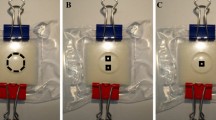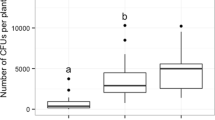Abstract
The success of combined release of the predatory mitesPhytoseiulus persimilis and Neoseiulus californicus insuppression of spider mites may be related to the effects of the interactionsbetween the two predators on their population dynamics. We studied populationgrowth and persistence of the specialist P. persimilis andthe generalist N. californicus reared singly versus rearedin combination after simultaneous and successive predator introductions ondetached bean leaf arenas with abundant prey, Tetranychusurticae, and with diminishing prey. When reared singly with abundantprey, either predator population persisted at high densities to the end of theexperiment. In every predator combination system with abundant prey and variousinitial predator:predator ratios N. californicus displacedP. persimilis. When held singly with diminishing prey, thepopulation of P. persimilis grew initially faster than thepopulation of N. californicus but both species reachedsimilar population peaks. Irrespective whether reared singly or in combination,N. californicus persisted three to five times longer afterprey depletion than did P. persimilis. Regarding thecrucial interactions in the predator combination systems, we conclude thatintraguild predation was a stronger force than food competition and finallyresulted in the displacement of P. persimilis. Previousstudies showed that intraguild predation between the specialist P.persimilis and the generalist N. californicusisstrongly asymmetric favoring the generalist. We discuss the implications ofpotential interactions between P. persimilis andN. californicus to biological control of spider mites.
Similar content being viewed by others
References
Blümel S. and Walzer A. 2002. Efficacy of different release strategies of Neoseiulus californicus McGregor and Phytoseiulus persimilis Athias Henriot (Acari: Phytoseiidae) for the control of two-spotted spider mite (Tetranychus urticae Koch) on greenhouse cut roses. Syst. Appl. Acarol. (submitted).
Castagnoli M. and Falchini L. 1993. Suitability of Polyphagotarsonemus latus (Banks) (Acari Tarsonemidae) as prey for Amblyseius californicus (McGregor) (Acari Phytoseiidae). Redia 76: 273-279.
Clements D.R and Harmsen R. 1992. Stigmaeid-phytoseiid interactions and the impact of natural enemy complexes on plant-inhibiting mites. Exp. Appl. Acarol. 14: 327-341.
Croft B.A. and MacRae I.V. 1992a. Biological control of apple mites by mixed populations of Metaseiulus occidentalis (Nesbitt) and Typhlodromus pyri Scheuten (Acari: Phytoseiidae). Environ. Entomol. 21: 202-209.
Croft B.A. and MacRae I.V. 1992b. Persistence of Typhlodromus pyri and Metaseiulus occidentalis (Acari: Phytoseiidae) on apple after inoculative release and competition with Zetzellia mali (Acari: Stigmaeidae). Environ. Entomol. 21: 1168-1177.
Croft B.A., Monetti L.N. and Pratt P.D. 1998. Comparative life histories and predation types: are Neoseiulus californicus and N. fallacis (Acari: Phytoseiidae) similar type II selective predators of spider mites? Environ. Entomol. 27: 531-538.
Croft B.A., Luh H.-K. and Schausberger P. 1999. Larval size relative to larval feeding, cannibalism of larvae, egg or adult female size and larval-adult setal patterns among 13 phytoseiid mite species. Exp. Appl. Acarol. 23: 599-610.
Dosse G. 1958. Ñber einige neue Raubmilbenarten (Acar. Phytoseiidae). Pflanzensch. Ber. 21: 44-61.
Duso C. 1989. Role of the predatory mites Amblyseius aberrans (Oud.), Typhlodromus pyri Scheuten and Amblyseius andersoni (Chant) (Acari, Phytoseiidae) in vineyards. I. The effects of single or mixed phytoseiid population releases on spider mite densities (Acari, Tetranychidae). J. Appl. Entomol. 107: 474-492.
Duso C. and Vettorazzo E. 1999. Mite population dynamics on different grape varieties with or without phytoseiids released (Acari: Phytoseiidae). Exp. Appl. Acarol. 23: 741-763.
Ehler L.E. 1992. Guild analysis in biological control. Environ. Entomol. 21: 26-40.
Faraji F., Janssen A., Van Rijn P.C.J and Sabelis M. W. 2000. Kin recognition by the predatory mite Iphiseius degenerans: discrimination among own, conspecific, and heterospecific eggs. Ecol. Entomol. 25: 147-155.
Ferguson K.I. and Stiling P. 1996. Non-additive effects of multiple natural enemies on aphid populations. Oecologia 108: 375-379.
Field R.P. and Hoy M.A. 1986. Evaluation of genetically improved strains of Metaseiulus occidentalis (Nesbitt) (Acarina: Phytoseiidae) for integrated control of spider mites on roses in greenhouses. Hilgardia 54: 1-31.
Friese D.D. and Gilstrap F.E. 1985. Prey requirements and developmental times of three phytoseiid species predaceous on spider mites. Southwest. Entomol. 10: 83-88.
Gillespie D.R. and Quiring D.J. M. 1992. Competition between Orius tristicolor (White) (Hemiptera: Anthocoridae) and Amblyseius cucumeris (Oudemans) (Acari: Phytoseiidae) feeding on Frankliniella occidentalis (Pergande) (Thysanoptera: Thripidae). Can. Entomol. 124: 1123-1128.
Gilstrap F.E. and Friese D.D. 1985. The predatory potential of Phytoseiulus persimilis, Amblyseius californicus, and Metaseiulus occidentalis (Acarina: Phytoseiidae). Int. J. Acarol. 11: 163-168.
Hamlen R.A. and Lindquist R.K. 1981. Comparison of two Phytoseiulus species as predators of twospotted spider mites on greenhouse ornamentals. Environ. Entomol. 10: 524-527.
Helle W. and Sabelis M.W. 1985. Spider mites: Their biology, natural enemies and control. Vol. 1.B. Elsevier, Amsterdam.
Holt R.D. and Polis G.A. 1997. A theoretical framework for intraguild predation. Am. Nat. 149: 745-764.
Janssen A., Pallini A., Venzon M. and Sabelis M.W. 1997. Behaviour and indirect interactions in food webs of plant-inhibiting arthropods. Exp. Appl. Acarol. 22: 497-521.
Janssen A., Pallini A., Venzon M. and Sabelis M.W. 1999. Absence of odour-mediated avoidance of heterospecific competitors by the predatory mite Phytoseiulus persimilis. Entomol. Exp. Appl. 92: 73-82.
Laing J.E. and Huffaker C.B. 1969. Comparative studies of predation by Phytoseiulus persimilis Athias-Henriot and Metaseiulus occidentalis (Nesbitt) (Acarina: Phytoseiidae) on populations of Tetranychus urticae Koch (Acarina: Tetranychidae). Res. Popul. Ecol. 11: 105-126.
Laing J.E. and Osborn J.A.L. 1974. The effect of prey density on the functional and numerical responses of three species of predatory mites. Entomophaga 19: 267-277.
McMurtry J.A. and Croft B.A. 1997. Life-styles of phytoseiid mites and their roles in biological control. Annu. Rev. Entomol. 42: 291-321.
Overmeer W.P.J. 1985. Alternative prey and other food resources. In: Helle W. and Sabelis M.W. (eds), In Spider mites: Their biology, natural enemies and control. Elsevier, Amsterdam, pp. 131-137.
Polis G.A., Myers C.A. and Holt R.D. 1989. The ecology and evolution of intraguild predation: potential competitors that eat each other. Annu. Rev. Ecol. Syst. 20: 297-330.
Rosenheim J.A., Wilhoit L.R. and Armer C.A. 1993. Influence of intraguild predation among generalist insect predators on the suppression of an herbivore population. Oecologia 96: 439-449.
Rosenheim J.A., Kaya H.K., Ehler L.E., Marois J.J. and Jaffee B.A. 1995. Intraguild predation among biological-control agents: theory and evidence. Biol. Control 5: 303-335.
Schausberger P. 1997. Inter-and intraspecific predation on immatures by adult females in Euseius finlandicus, Typhlodromus pyri and Kampimodromus aberrans (Acari, Phytoseiidae). Exp. Appl. Acarol. 21: 131-150.
Schausberger P. 1998. Population growth and persistence when prey is diminishing in single species and two species systems of the predatory mites Typhlodromus pyri, Euseius finlandicus and Kampimodromus aberrans. Ent. Exp. Appl. 88: 275-286.
Schausberger P. 1999. Predation preference of Typhlodromus pyri and Kampimodromus aberrans (Acari, Phytoseiidae) when offered con-and heterospecific immature life stages. Exp. Appl. Acarol. 23: 389-398.
Schausberger P. and Croft B.A. 1999. Predation on and discrimination between con-and heterospecific eggs among specialist and generalist phytoseiid mites (Acari: Phytoseiidae). Environ. Entomol. 28: 523-528.
Schausberger P. and Croft B.A. 2000. Cannibalism and intraguild predation among phytoseiid mites: are aggressiveness and prey preference related to diet specialization? Exp. Appl. Acarol. 24: 709-725.
Schausberger P. and Walzer A. 2001. Combined versus single species release of predaceous mites: predator-predator interactions and pest suppression. Biol. Control 20: 269-278.
Shorrocks B. and Begon M. 1975. A model of competition. Oecologia 20: 363-367.
Swirski E., Amitai S. and Dorzia N. 1970. Laboratory studies on the feeding habits, post-embryonic survival and oviposition of the predaceous mites Amblyseius chilenensis Dosse and Amblyseius hibisci Chant (Acarina: Phytoseiidae) on various kinds of food substances. Entomophaga 15: 93-106.
Walzer A. and Blümel S. 1999. Effect of different prey amounts on the population development of the phytoseiid mites Phytoseiulus persimilis and Neoseiulus californicus in a single-and in a two-species system on detached rose leaves. IOBC/WPRS Bull. 22: 275-278.
Walzer A. and Schausberger P. 1999a. Cannibalism and interspecific predation in the phytoseiid mites Phytoseiulus persimilis and Neoseiulus californicus: predation rates and effects on reproduction and juvenile development. BioControl 43: 457-458.
Walzer A. and Schausberger P. 1999b. Predation preferences and discrimination between con-and heterospecific prey by the phytoseiid mites Phytoseiulus persimilis and Neoseiulus californicus. Bio-Control 43: 469-478.
Wittmann E.J. and Leather S.R. 1997. Compatibility of Orius laevigatus Fieber (Hemiptera: Anthocoridae) with Neoseiulus (Amblyseius) cucumeris Oudemans (Acari: Phytoseiidae) and Iphiseius (Amblyseius) degenerans Berlese (Acari: Phytoseiidae) in the biocontrol of Frankliniella occidentalis Pergande (Thysanoptera: Thripidae). Exp. Appl. Acarol. 21: 523-538.
Yao D.S. and Chant D.A. 1989. Population growth and predation interference between two species of predatory phytoseiid mites (Acarina: Phytoseiidae) in interactive systems. Oecologia 80: 443-445.
Author information
Authors and Affiliations
Rights and permissions
About this article
Cite this article
Walzer, A., Blümel, S. & Schausberger, P. Population dynamics of interacting predatory mites, Phytoseiulus persimilis and Neoseiulus californicus, held on detached bean leaves. Exp Appl Acarol 25, 731–743 (2001). https://doi.org/10.1023/A:1016332129137
Issue Date:
DOI: https://doi.org/10.1023/A:1016332129137




